Welding power supplies take alternating or direct current from a power line or portable generator and convert it to current usable at the welding arc.
The National Electrical Manufacturers Association (NEMA) Standards Publication EW1, Electric Arc Welding Power Supplies, and manufacturers’ literature provide construction and performance specifications and requirements for individual machines.
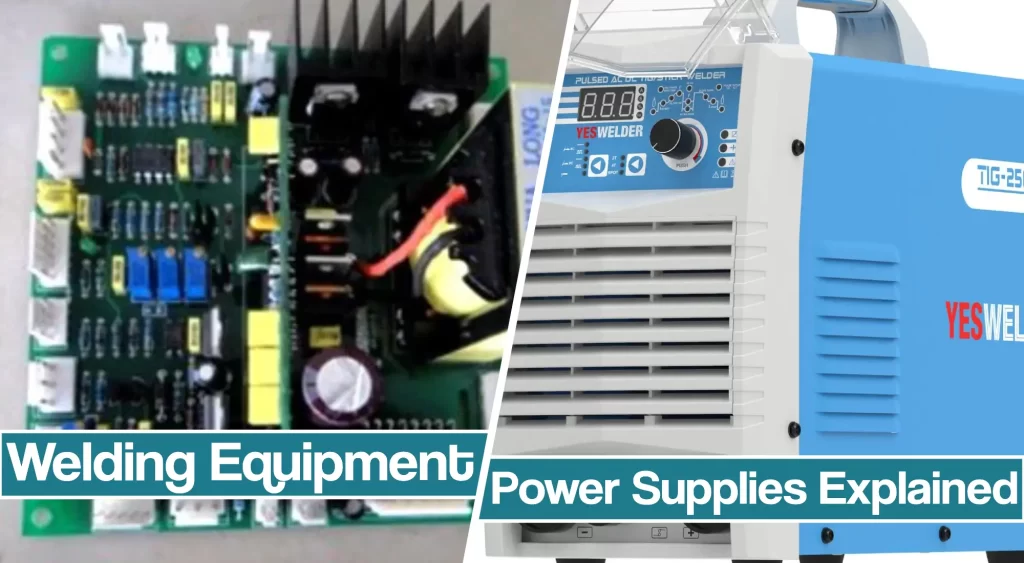
Among types of power supplies, alternating current (AC) transformers are the least costly most use 230 V single-phase input power. Direct-current (DC) transformer-rectifiers convert ac to dc, using single or three-phase power to produce a constant voltage (CV) or variable voltage (VV).
A constant current (CC) power source has a volt-ampere relationship that yields a small current change from a large arc voltage change. AC-DC transformer-rectifiers do both AC and DC welding.
Transformer-rectifiers have moveable parts subject to wear and tear. However, these machines can produce some of the best arc characteristics.
A silicon-coated-rectifier (SCR) power source, electronically voltage-controlled, has no moving parts other than the primary current contactor and cooling fan—the only parts that can wear out.
Some recent designs even eliminate the mechanical contactor to improve reliability. The SCR machine is among the most popular power sources. However, the SCR power source has limitations if a fabricator requires pulsed welding, and inverters become the power supply of choice.
AC/dC inverters
Inverter welding machines convert AC input frequency to very high frequencies—up to 1,000 times that of input frequency—allowing transformers and other components to be small in size and the power supply to be relatively lightweight.
This high operating frequency enables the inverter to precisely control output power and delivers smooth arc initiation with minimal or no spatter.
The current ripple is low for a very stable arc, even at low amperages. And the improved arc control helps to minimize electrode overheating and fume emissions.
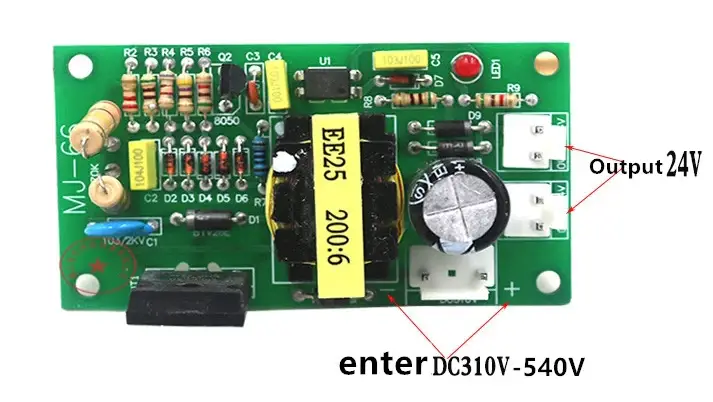
Finally, small transformers allow for more efficient use of primary power, and compared to conventional power supplies—energy savings can be substantial.
Multiple-operator Welding Power Supplies
Multi-operator power supplies use a high amperage high-voltage power source to feed power to more than one welding station.
Where line power may be unavailable, as in the field, contractors operate engine-driven generators powered by natural gas, propane, or diesel fuel.
Units rate 150 to 650 A at up to a 100-percent-duty cycle, and some are rated as high as 10,000 W, to provide power for additional power tools, lighting, cooling, or other requirements.
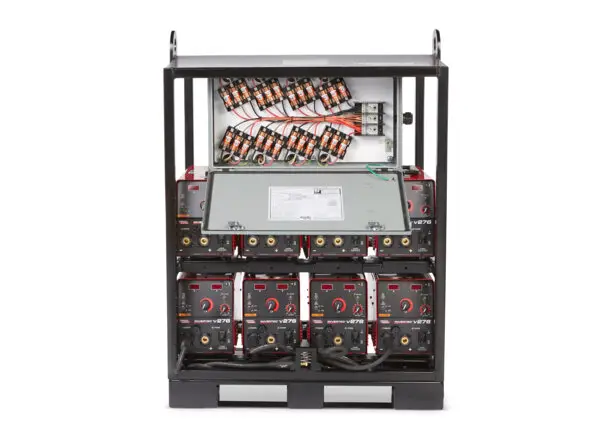
For welding in confined spaces, damp, wet, or awkward locations, AC power supplies pose more of an electric-shock hazard than DC power supplies. Use DC power supplies in these cases when possible; also, try to weld using the GMAW process rather than SMAW, due to the lower open-circuit voltages associated with GMAW. You can learn more about AC and DC welding differences in our separate article.
When using an AC power supply, outfit it with a low open-circuit-voltage attachment to limit open-circuit voltage to 35 V maximum during non welding times.
Power Supplies by Welding Process
Shielded Metal Arc Welding – SMAW
A manual process, shielded-metal-arc welding (SMAW), performs in a shop or field. The process requires a cc-power supply, 25 to 500 amperes, 15 to 35 V. Given the correct electrode, almost any cc welding machine, AC or DC, can be used for shielded-metal-arc welding, depending on the composition of the electrode coating.
Gas Metal Arc Welding – GMAW or MIG
Gas-metal-arc welding (GMAW) calls for continuous filler-metal wire and shielding gas to protect the weld pool as wire feeds into the arc. The process requires a direct current arc operating at 15 to 35 V, 30-600 A.
Specify a CC machine that gives constant melt rate and variable wire feed; a CV power supply provides continuous wire feed.
Inverters for GMAW feature electronic inductance control, enabling the welder to fine-tune the arc for minimal spatter and optimum weld-bead wetting action, and are particularly useful when welding stainless steels and nickel-based alloys.
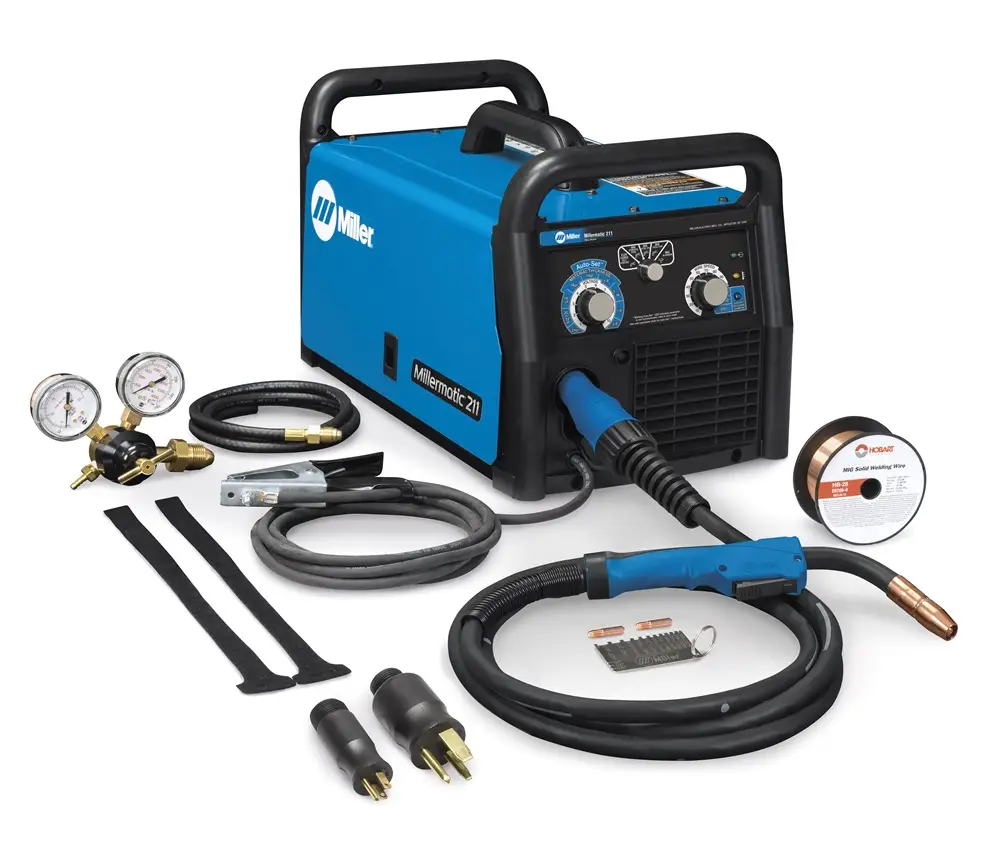
Welding-site conditions and welding-wire diameter combine to affect the efficiency and size of the power supply required for a job. A 100A unit that runs from a single-phase 115-V input can be used for low-duty-cycle sheet welding to 0.125-in. thick, feeding wire to 0.030-in. diameter; while medium-duty power supplies, 150-200 A, normally take single-phase 220-V input are used to weld steel to 0.1875-in. and 0.035-in. wire at low duty cycles.
For high-duty cycles, as in mechanized welding, a 250-A machine, single or three-phase input at various voltages should be used to materials to 0.035 in. thick with wire as large as 0.0833-in. diameter. Taking three-phase input only and wire up to 0.1875-in. diameter, 400-amp units serve for mechanized continuous-welding applications.
Pulsed GMAW
For pulsed GMAW, shops use an inverter and transistor power sources, constant-current or constant-voltage, that offer independent settings of pulse parameters. They employ synergic controls preprogrammed for a range of wire-feed speeds-the operator sets only one dial, for average current.
Flux Cored Arc Welding – FCAW
For flux-cored-arc welding, shops use CV or CC types, 300 to 1,500 A, 25 to 50 V, rated 60- to 100-percent-duty cycle. Cv types are more popular because wire feed speed, set before welding, controls the welding current. Cc types require a variable-speed or voltage-sensing wire feeder.
Gas Tungsten Arc Welding – GTAW or TIG
Gas-tungsten-arc welding (GTAW) requires a constant-current (AC or DC) power supply with a steep volt-amp curve to minimize current change for variation in voltage or arc length. They are rated to 1,500 A, 10 to 75 V, at 40- to 100-percent-duty cycle.
Most GTAW power supplies are equipped with high-frequency circuitry for arc initiation and stabilization, gas valves, and cooling-water valves for high-current welding.
A High-frequency arc start is useful when the maximum open-circuit voltage allowed by NEMA standards, 80 to 100 V, will not establish and maintain a stable arc.
On the other hand, many DC TIG power supplies are equipped with a lift start feature for GTAW welding. When the welder touches the tungsten electrode to the workpiece, a small amount of current—15-20 A—flows.
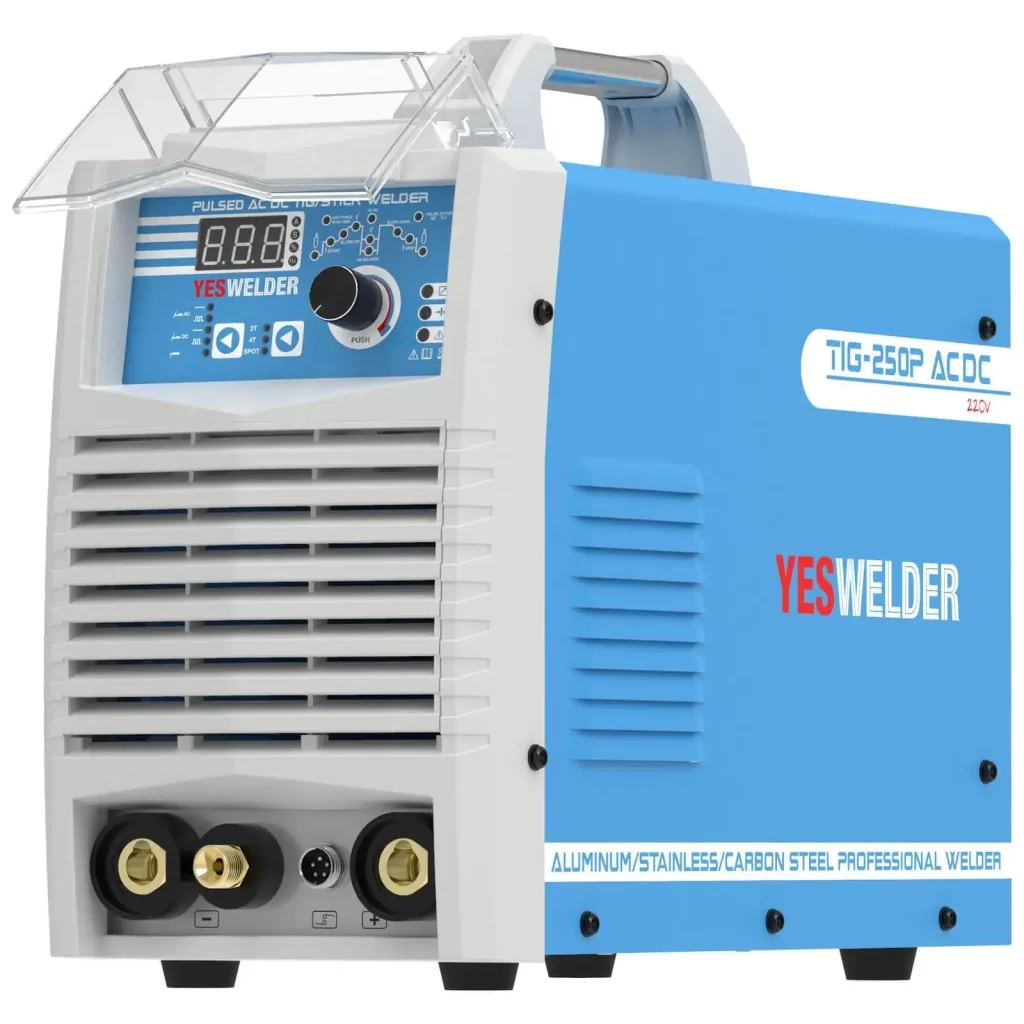
When the operator lifts the electrode from work, the arc starts softly, and the machine switches to the set weld-current value. This low-current starting minimizes weld contamination caused by touching the tungsten to the workpiece and eliminates the need for high-frequency starting.
AC TIG Welding Aluminum and Magnesium Alloys
For AC-GTAW of Aluminum Alloys, advances in ways to manipulate the AC waveform have developed from using inverter-based power sources that allow welders to extend the balance control, adjust output frequency and independently control current in each AC half-cycle.
New inverter-based GTAW machines extend electrode negative (EN) balance control, allowing duration from 50 to 90 percent.
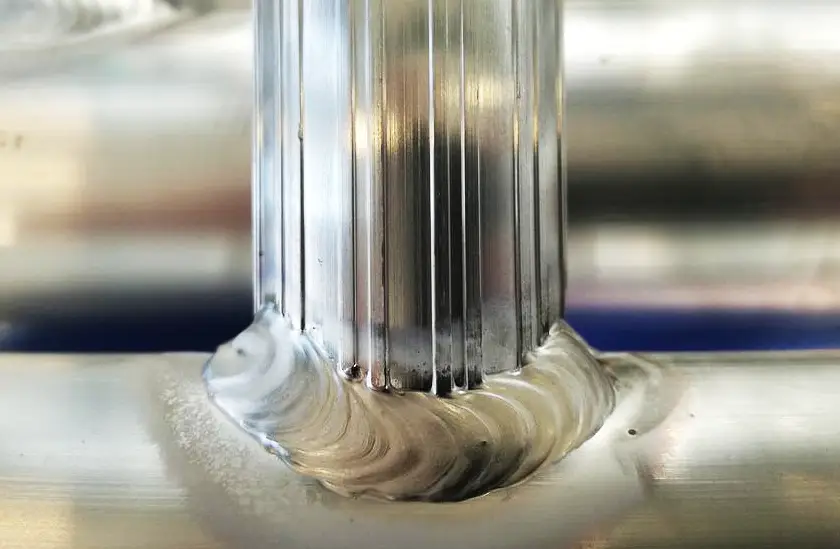
Making the DCEN portion of the cycle last longer and provides for greater weld penetration, increased travel speeds, a narrower weld bead, more precise direction of the heat or the deposit of a narrower weld bead because a smaller-diameter tungsten electrode can be used, and a smaller etched zone for improved cosmetics.
Reduced DCEN time improves cleaning action to remove heavier oxidation, lessens penetration, and widens the bead profile. There are no hard rules about setting balance control, but the typical error made in weld shops involves overbalancing the cycle, which results in excessive cleaning action (electrode-positive duration).
This causes excess heat build-up on the tungsten, forming a large ball on the end of the electrode. Subsequently, the arc loses stability, and the operator loses the ability to control the direction of the arc and weld puddle. Arc-starts begin to degrade as well.
Conversely, excessive penetration (or insufficient electrode-positive duration) results in a dirty weld puddle. If the puddle looks like it has black pepper flakes floating on it, cleaning action has to be increased to blast away oxides and other impurities.
TIG Welding Frequency Setting On the Power Source
Inverter-based TIG machines also let operators adjust the welding-output frequency from 20 to 250 Hz; conventional machines have a fixed output of 60 Hz.
Decreasing frequency produces a broader arc cone, which widens the weld-bead profile and better removes impurities from the surface of the workpiece. It also transfers the maximum amount of energy to the workpiece, which is ideal for work requiring heavy metal deposition, such as building up a worn part or making a fill pass.
Increasing frequency produces a tight, focused arc cone, narrowing the weld bead, which is helpful when welding in corners, on root passes, and fillet welds. The operator can direct the arc precisely at the joint and prevent the arc from dancing from plate to plate. Also, operators can use pointed tungsten, which further improves arc control and bead shape.
DCEN and DCEP Ampereage Output Control
Independent amperage control of the DCEN and DCEP portions of the AC cycle allows operators to fine-tune the amount of energy directed into the workpiece, and to take the heat off the tungsten electrode.
Independently increasing DCEN amperage while maintaining or reducing DCEP amperage also:
Narrows the arc cone, nearly eliminating the etched zone at the toes of welds.
Lets the operator use a smaller diameter electrode to make narrower welds (for example, using a 0.09375-in. diameter electrode to weld at 280 A DCEN).
May allow the use of straight argon shielding gas in place of a costly argon-helium mix. Argon-helium produces more heat than straight argon. However, straight argon may suffice in most applications if heat input is increased by boosting DCEN amperage.
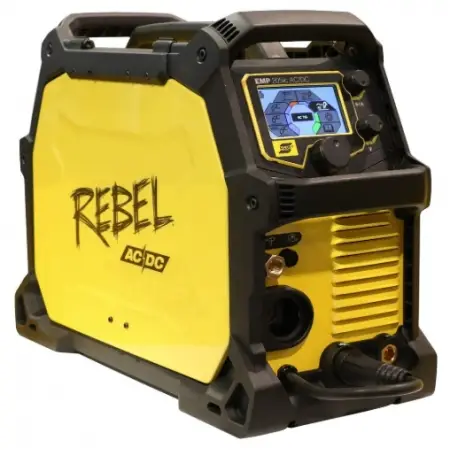
Differences Between High-End TIG Power Supplies
A basic, professional-quality AC GTAW power supply lets the operator adjust four variables: amperage, balance control, and shielding-gas pre-flow and post-flow time. Pre-flow of shielding gas purges the immediate weld area from contaminants in the surrounding atmosphere, and it aids with arc initiation.
The operator who prefers a full-featured machine looks for additional sequencer controls—start current and time, crater time, and final current.
It may also include spot time and pulsing. Start controls allow the operator to generate a hotter or cooler start in comparison to the welding amperage.
Thick aluminum sections, which act as a giant heat sink, benefit from hot starts because the extra amperage on start-up helps form a puddle more quickly. Conversely, thin sections, at risk of melting or warping, benefit from a cool start.
How To Select a Welding Power Source
When choosing a power source, start by checking NEMA specs.
NEMA Class I arc-welding power sources deliver rated output at 60-, 80-, or 100-percent-duty cycles. Class II units, 30-, 40-, or 50-percent; and Class III, 20 percent.
First, consider capacity and kind of current needed for the job. Rely on the manufacturer’s rating as being conservative: do not buy more capacity than needed.
Choose low-duty-cycle machines only for maintenance or for intermittent welding. Inverter units should be considered if portability is important.
With the advent of the CE-mark requirements in Europe, many manufacturers now design to the International Standard IEC 974-1. One of the requirements of this standard is to place an IP rating on the machine’s nameplate to indicate the degree of protection provided by the enclosure that helps to avoid damage from water and foreign objects.
Features and Options
Communication Between Power Supplies
Serial-data communications give power supplies the capability to “talk to each other,” which is useful when a company wants to input the same welding procedures into several machines at once or monitor the welding consistency and performance of several machines from a single location.
Fabricators can connect some machines to a personal computer to monitor performance, and download welding parameters to the machines for fast setup.
High-end machines will calculate the pounds of weld wire used per machine. The machine can also monitor the average welding current and voltage used so that limits can be set on the machine and how often those parameters were in or out of the limits.
Remote Control And Supervision
Remote control of current and voltage is beneficial if the welding operator is located away from the power source.
Robotic and automatic applications generally require high-duty-cycle power supplies, and controls and connections for interfacing the robot or automatic fixture.
Supervisory control of the process can prevent the welder from changing the welding procedures.
To do this, a power supply or controller that enables the supervisor to program the procedures must be used and locked. Some power supplies or controllers offer the welder limited control of the process.
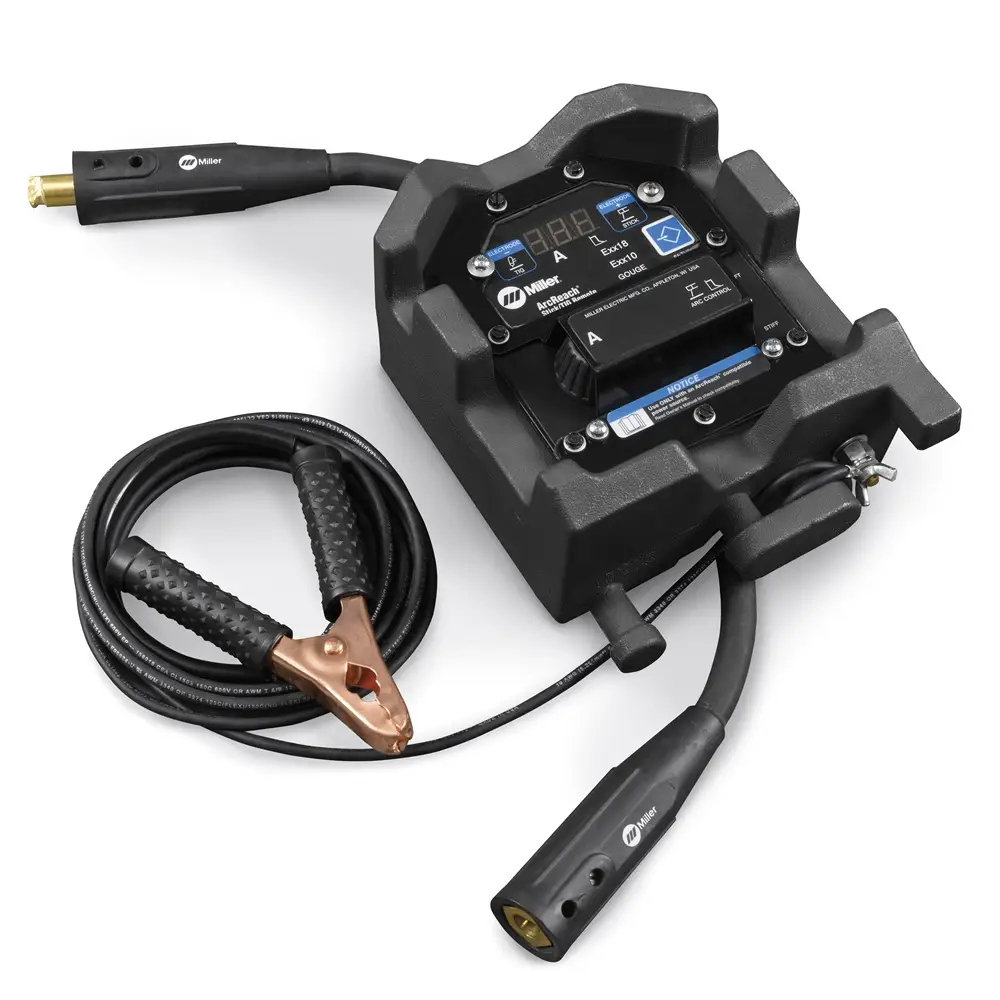
Input Power
Input power to power supplies can be single-and/or three-phase, with voltage from 115 to 575 V and input frequencies of 50, 60, or 50/60 Hz. Many inverter power supplies are designed to operate on both single-and three-phase input, and have an automatic input-voltage selection and linking.
Duty-Cycle Rating
The power-supply rating depends on the type and thickness of the workpiece and the length of time it takes to deposit the longest weld on the thickest material.
The duty cycle is the crucial factor to consider when selecting a power source. A review of duty-cycle requirements is needed after the current and voltage required to accomplish the weld have been determined.
The duty-cycle rating is the percentage of time during a 10-minute period that a power supply can operate at rated output amperage without overheating.
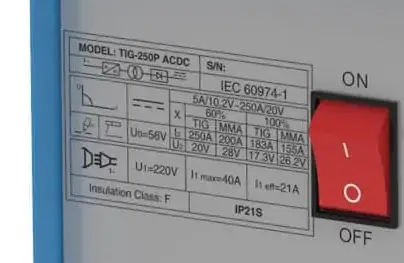
A machine rated 300 A at 60-percent duty cycle can weld for 6 minutes at 300 A during any 10-minute period. After that, the welder must rest the machine for the next 4 minutes to avoid overheating the unit.
To calculate the duty cycle at any output, use this equation:
Allowable duty cycle = Rated duty cycle (Rated amperage/required amperage)^2
Using this formula, the duty cycle at 400 A would be 34 percent. By rearranging the formula, the welder can calculate the amperage rating at a 100-percent-duty cycle to be 232 A.
Therefore, the unit can work at amperages higher than 300 A at a slower pace and can weld continuously at 232 A.
Production vs. Repair Applications
In general, production applications require high-duty-cycle power supplies, and repair applications can use low-duty-cycle portable units.
Welding Torches and Guns
Used for shielded-metal-arc welding, torches (electrode holders), manually controlled, grip ends of electrodes, also called rods-pinch type and collet type, are common.
GMAW and FCAW guns come in pistol-grip, goose-neck, and in-line styles, used for mechanized welding. A MIG gun should be selected after the wire diameter is known, and with a gun rating slightly higher than the welding current that will be used.

A gun used for welding under 200 A, must have a rating that matched its power supply. A 400-A air-cooled MIG gun should be used for argon shielding-gas mixtures, welding at 200-350 A and less than a 60-percent-duty cycle.
A water-cooled gun should be used for welding at 200 A and higher, and for duty cycles over 60 percent. A 600-A, air-cooled gun can be used for welding up to 350 A at duty cycles less than 60 percent.
GTAW torches come air-cooled and water-cooled. Their heads align in-line with the body or at 90, 120, or 135 degrees to it. Nozzles, specified by inside diameters, run 0.25 to 0.625-in. Vendors offer special-design nozzles and lenses, longer to give improved accessibility to the weld joint, or wider to extend shielding gas coverage.
Saw guns come in three types-side, concentric, and deep-groove flux delivery.
In oxyfuel welding (OFW), heat comes from burning gases, rather than arcs. Torches hold separate tubes for fuel gas and oxygen, blended in a mixer assembly.
A torch assembly comprises a handle (aluminum, stainless steel, or brass); a mixing chamber; and a brass welding tip or cutting head. Light-duty torches weld sheet metal to 0.1875-in. thick; medium, to 0.833-in.; heavy, 0.833-in. and up. Specifying tips by orifice diameter or drill size, manufacturers recommend tip sizes based on material and thickness to be welded.
Wire Feeders
GMAW, FCAW, some GTAW processes like hot wire GTAW-HW, and SAW guns require wire feeders, constant-speed, and constant-voltage models, to guide the electrode wire smoothly and continuously into the arc.
Integral with small power supplies or as separate units, these devices push or pull (some do both) filler wire into the welding gun at speeds from 50 to 900 in./min.
Wire feeders come as bench models for mounting on top of a power supply or on a portable undercarriage.
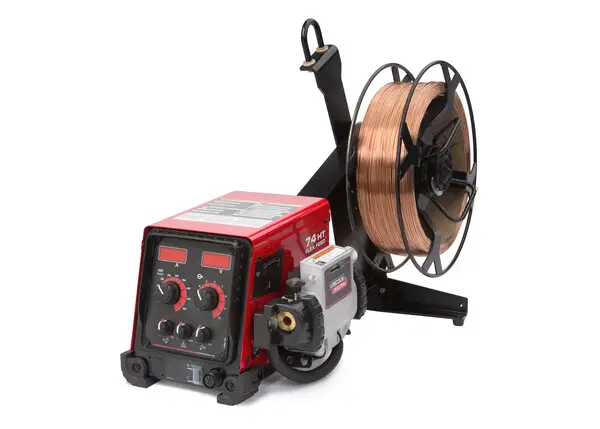
For mounting from a jib crane or boom, look for models that allow the drive, wire-reel stand, and control box to be separated. For boom mounting, they typically come with remote control and cables.
Newest are microprocessor-based programmable wire feeders with digital motor-speed control and tachometer feedback, delivering optimum arc control and particularly useful for pulsed welding.
Shops can store several synergic-pulsed programs, usually factory-set, in the wire-feeder memory so that the operator simply selects wire and shielding-gas type, and the wire feeder does the rest.
Some of these wire feeders feature digital communication to synchronize the wire feeder and power supply to ensure consistent performance even if the two components are separated. Other features that are available include:
- Automatic wire-tension adjustment
- Wire-guiding devices to minimize wire tangling.
- Two independently driven heads, for versatility, that enable the welder to switch from one wire type to another by simply pulling the gun trigger or pushing a button on the feeder.
- Multifunction control of parameters such as gas-preflow time and run-in wire-feed speed and voltage.
- Rotating feeder-head assembly to minimize gun-cable kinks and bends.
- Control of background current upon arc strike to ensure soft and consistent starts.
- Dual-procedure control that allows an increase or decrease in arc energy without changing wire-feed speed.
- Control circuitry compensates for load-and-line voltage fluctuation to maintain consistent wire-feed speed.
- Optional flowmeter kits enable operators to connect gas lines to the back of the wire feeder, enabling the welder to check the shielding-gas flow rate right at the feeder.
Some suppliers are offering wire feeders redesigned to satisfy CE and NEMA standards. New features include insulated bases that isolate the control box from the base, and ground-fault protection.
Select wire-feeder range to fit expected welding conditions. For outdoor work, select a model housed in an impact-resistant plastic case; the toughest models on the market are steel-reinforced and flame retardant.
For work in particularly dusty or dirty conditions, look for models with covered drive-roll assemblies.
Where welders are required to switch among two wires of different sizes or types, opt for dual-wire models—a common application is running conventional GMAW from one side and pulsed GMAW on the other.
Constant-speed wire feeders are best for GMAW, FCAW, and for SAW with small-diameter wires. Used with constant-current power supplies, CV types are recommended for GMAW of aluminum, FCAW, and for SAW with large-diameter wires.
Electroslag welding equipment includes a wire feeder (constant-speed, similar to those for other continuous electrode processes), guide tubes (beryllium-copper or steel), and retaining shoes (copper).
Opt for four-roll feeders for highspeed feeding of small-diameter wire, such as 0.023- or 0.035-in. diameter at up to 900 in./min. Fourroll feeders will result in less slippage than two-roll feeders. Highspeed feeding of small wires minimizes heat input and distortion when welding thin-gauge materials.





